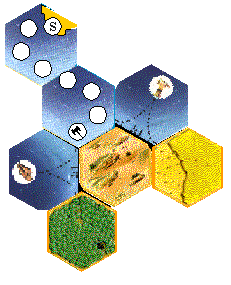

|
Please read this overview first, it outlines the most
important changes with respect to the basic game.
Then read part B on the following pages 2 to 4 first - the new
additional game control.
The big illustration below shows a prepared playing board that you
should at least employ in the first game.
The small illustrations show the new raw material gains per town.
In the Part C, you find tips to the development cards, a
material list and notes on pasting the playing figures.
|
1 |
Catan is in danger - dark cloud gather over the peaceful Catans. Wild barbarians, lured by Catan's wealth, sail here to invade the country. |
2 |
Enough time still remains in order to stop the danger. The number of barbarians always corresponds to the number of the towns in Catan. When the barbarian army strike, the sum of all knights every player has has to be at least as strong as the barbarians. |
3 |
If it succeeds to conquer the barbarians, the danger is for the moment eliminated. However, are the knights of Catan too weak, then the barbarians invade a city. The invaded city becomes looted and remains as a settlement. |
4 |
This loss always hits the player who contributed with no or with the fewest knights to the defense of Catan. Do not tempt fate, but create knights. |
5 |
Apart from this external enemy, the players might compete ferociously for the building of three metropolises! To construct a metropolis - worthing two victory points - the players have to develop their city. |
6 |
The city development is only possible with the aid of the new "commodities" cards. A player only receives commodities for cities which border ore mines, forest or pastures. |
7 |
In the beginning everyone starts with a settlement and a city. If you receive raw materials for a city bordering on ore mines, forest or pastures, you receive only 1 raw material card, but additionally you get a corresponding commodity. |
8 |
You develop your cities with cash in the direction of politics (blue); paper makes the expansion possible in the direction of science (green) and cloth makes the expansion possible in the direction of trade (yellow). You receive a Metropolis (+ 2 victory points) as soon as you get to the fourth configuration level, if you are the first to have got there. |
9 |
Continuing city development increases your chance - through the fitting combination of red numbered die and event die - of getting new develoment cards, which enable considerably deeper interventions into the game than before. |
10 |
Therefore, prepare yourselves for a hard life in Catan - and to a longer game. The one to achieve 13 victory points firstly wins. |
Despite the variable playing board we recommend you to use - for the first time you play - the starting playing board from the figure: thus it is guaranteed that there is sufficient quantity of raw material in play - above all grain.
The following materials are organized on table in the following way:
Each player selects a colour and receives:
Settlements and cities - the beginning:
Important: Make sure that you have acces to grain and does not forget that only three fields produce "commodities"!
Exception: Before the dice have been rolled the "Alchmist" is the only development card that can be played.
After the player threw all three dice, the dice results are processed in the following order:
If it shows the ship symbol, then the ship approaches one circle towards Catan. If the ship achieves the last circle (with the axe), then the army of the barbarians lands on Catan. The players must have activated knights in order to be able to strike back the barbarians. See details on "fighting the barbarians army".
If it shows a city-gate symbol, then all players check whether they may pull a "development card". In order to receive a development card a player must:
The commercial possibilities of the basic game are preserved, the folowing applies to the new "commodities" cards.
The players can build roads, settlements and cities, if they are in turn, as they used to do in the basic game.
The new building possibilities are:

|
Knights are represented by wooden disks. One side of the disk shows a knight heading - the "passive side". A "passive" knight cannot undertake any action. The other side of the disk shows iron gloves - that is the "active side" - only with this side upward a knight can intervene in the play. |
| Knight may have one of the three levels: simple knights, strong knights and powerful knights. They are represented on the passive side by different heading size, on the active size by 1, 2 or 3 gloves. Each glove is for 1 point of strength. |
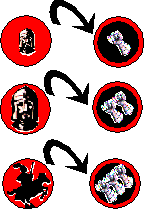
|
|
Example: Player red has four crossings (see arrows) on the figure, on
whose he could set up his knights. If the red player places his knight as
shown on crossing "A", he blocks the blue player - only red can build a road
now from that crossing. If red had placed his knight on crossing "B", he
would have interrupted the trade route of the blue player.
|
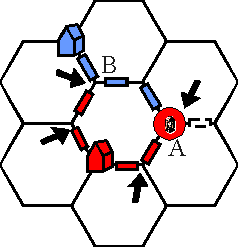
|
If a player has "commodity" cards, then he can develop his cities. Even if a player has only one city, he can still develop his city in all three areas (trade, politics, science).
City development are made with the help of the development calendar which is in front of the player. The development calendar has three separated blocks one for each of the three possible development areas: yellow-trade; blue-politics; green-science. In each area there are five stages of development, therefore each block has five pages. At the beginning of the play the block is closed, no player has yet developed a city in any area.
Guild (yellow): from now on exchange "commodities" in the ratio 2:1.
Fortress (blue): from now on upgrade "strong knights" to "powerful knights".
Aquaduct (green): from now on take any raw material, if when the dice is thrown you cannot take any raw material. Exception: when 7 is rolled.
Note (added by the translator): A variation of the Aquaduct (green) would be: "from now on take any raw material, if he does not have a settlement or a city on the border of a land field that contains the number rolled. Exception: when 7 is rolled."
Example: a player possesses a Metropolis, since he built a "cathedral" in the area politics. Another player builds now the "advice Catans", so he now receives the Metropolis from the other player, and this Metropolis cannot be lost in the future playing process anymore.
The awarding of "development cards" is attached to the following conditions:
Example: Player A rolled the dice with the white die=6, with the red die=3 and with the event die="yellow city-gate". The player B has already built a "city hall" (politics-blue) and a "guild" (science-yellow) and it is possible to see that he has developed his cities on the yellow direction and a red die with that "3" is shown, so he can pull a yellow development card.
The player that is in his turn, may during his turn arbitrarily play as many of his development cards as he wants - only after he rolled the dice (exception the Alchimist card).
A player that is in his turn, can execute a knight action, if he has active knights - the action is executed after he rolled the dice. After the action is executed, the knight must be turned to its passive side. The player can activate the knight immediately against payment of a grain raw material again - however in this turn he cannot execute another knight action with that knight.
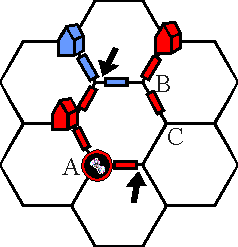
|
Example: Player Red may shift its activated knight (on crossing "A") to
the crossings marked with arrows. Shifting the knight to the crossings
"B" or "C" is not permitted, since these crossings are not connected by
roads with crossing "A".
|
|
Example: Player red may drive out the knight of the player blue using
his active knight because it is stronger than the knight of the player blue,
and it is on his trade route.
Player blue must shift now his refugee knight to crossing "A" or "B" (on his
trading route). Moving the refugee knight to crossing " C " is not permitted.
|
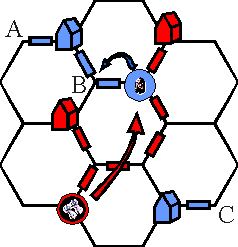
|
A player can drive the robber out with his active knight (no matter how strong), if the robber sits on one of the three neighbouring land fields.
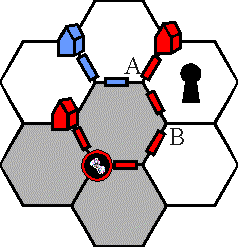
|
Example: The knight of player red could drive out the robber of the grey fields.
Unfortunately the robber sits outside of the sphere of influence of the knight.
In order to drive out the robber, the player must do as follows: he shifts the
knight to crossing "A" or "B" and deactivates it; then he pays
a grain raw material and activates the knight again; in his next turn
the player can drive out the robber.
|
As soon as the barbarian ship lands on the field with the axe (assault), the barbarian army fight with the active knights of Catan.
The barbarians win, if they are stronger than the knights of Catan. The barbarian army attack the cities or the players, who has the fewest (or none) active knights, and therefor contributed the least to the defense of Catan.
If the knights Catans are stronger or at least just as strong as the army of the barbarians, then they win.
The trader figure comes into play only when a development card "trader" is played. The player that played the development card "trader", places the trader figure on a land field beside one of his settlements or cities. That player only may exchange the raw material of this land field in the ratio 2:1, for as long as the trader stays on that land field. The trader figure can be shifted only when a new "trader" card is played. The trade figure is worth one victory point for the last player that played a "trade" card.
The game ends as soon as a player is in his turn and has 13 victory points.
The "Fiesepeter" rule for experienced settlers that still require more tactics, should try out this version. It adds a small, but very impressive rule modification: If the barbarian army landed, then all players decide, in clockwise way, beginning with the player that is in turn, how many of its knights he wants to use to fight the barbarians.
TIP: a player can consciously on the application of his knights werzichten, in order to let the barbarians win and so different players harm. Only who uses knights, it must deactivate after the decision.
Neither German nor English mother-tongue speaker :-), so do not expect much :-).
| Name | number in pack | Card Text | Additional remarks | |
|
||||
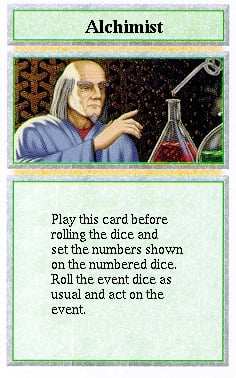 |
|
Play this card before rolling the dice and set the numbers shown on the number dice. Roll the event dice as usual and act on the event. | With this card you can pick numbers of your choice. First, though, the event is determined by rolling the event-die. Only then do you get the desired resources. | |
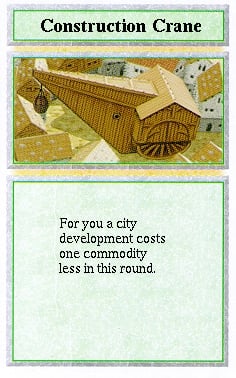 |
|
For you a city extension s.a. Rathaus (city hall) costs one commodity less in this round. | The crane only has effect for the round in which it is played. It only affects city extensions. Cities themselves have to be "paid" in full. | |
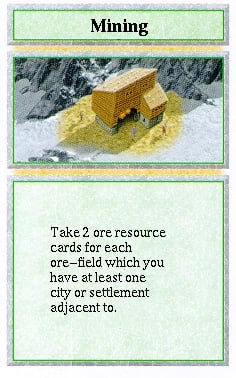 |
|
Take 2 ore resource cards for each ore-field which you have at least one city or settlement adjacent to. | It makes no difference for this card whether you have a city or a settlement
at an ore-field.
Ex.: you have two settlements adjacent to one mountain range (ore-field), and a city next to another. On playing the card you receive 4 ore resource cards. |
|
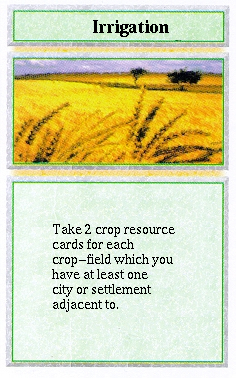 |
|
Take 2 cropresource cards for each crop-field which you have at least one city or settlement adjacent to. | As Bergbau / mining but for crops. | |
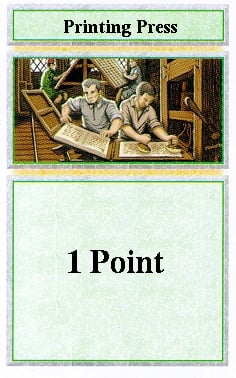 |
|
1 victory point | Development cards yielding victory points have to be played immediately and must be visible to all. They cannot be robbed. | |
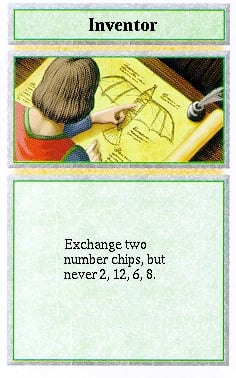 |
|
Exchange two number chips, but never 2, 12, 6, 8. | Improve your income of resources! Pick any two (except 2, 12, 6, 8) number chips and exchange them with one another. A robber does not affect the action and remains on the field he is on. | |
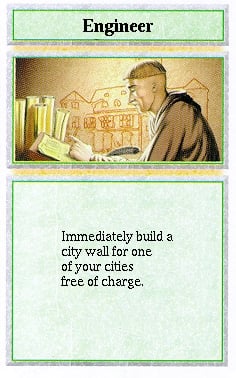 |
|
Immediately build a city wall for one of your cities free of charge. | More protection against the robber: take a city wall and place it underneath (one of ) your city(ies). When the robber event occurs (a 7 is rolled) you may have 2 resource cards more on your hand. You can only have one city wall per city. There are 3 city walls altogether. Settlements may not have city walls. | |
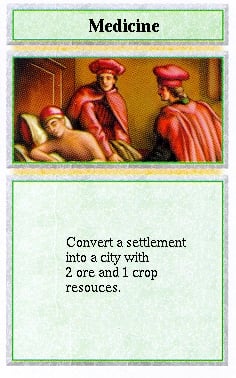 |
|
Convert a settlement into a city with 2 ore and one crop resource. | Playing the card saves you one ore and one crop resource card when building a city | |
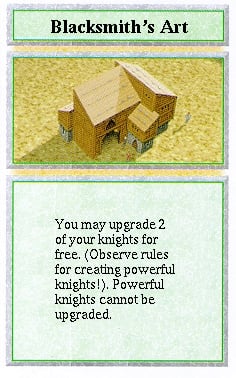 |
|
You may upgrade 2 of your knights for free (Observe rules for creating powerful knights!). Powerful knights cannot be upgraded. | You may upgrade passive and active knights. Strong knights (2nd level) can only be upgraded to mighty knights once you have completed the city extension fortress (Festung). Teh state of the knight does not change. A knight can only be upgraded one level per turn. | |
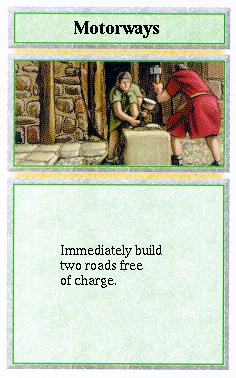 |
2 | Immediately build two roads free of charge. | If playing with Seefahrer/Mariner: also 1 road, one ship or two ships | |
| Name | number in pack | Card Text | Additional remarks |
|
|||
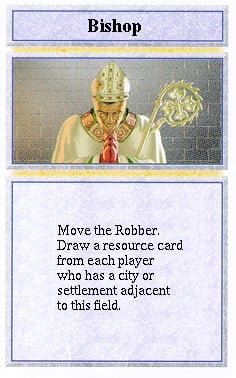 |
2 | Move the robber. Draw a resource card from each player who has a city or settlement adjacent to this field. | When moving the robber you may steal a card from every player who has a city or settlemenr adjacent to this field. If a player has built several times along this field, you may still only steal one card from him. |
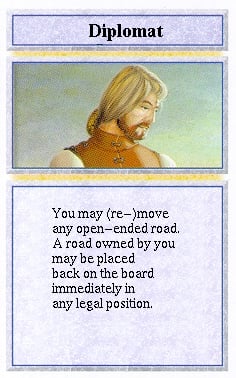 |
2 | You may (re-)move any open-ended road. A road owned by you may be placed back on the board immediately in any legal position | A road is open-ended if it is not connected on both ends to roads, cities, settlements or knights of the same colour. |
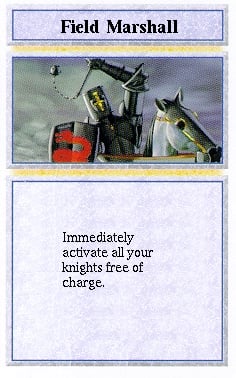 |
2 | Immediately activate all your knights free of charge | Activiating your knights does not cost you any crop-resources |
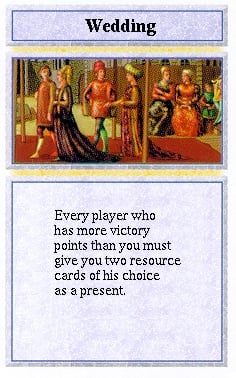 |
2 | Every player who has more victory points than you must give you two resource cards of his choice as a present. | If an affected player has only one card, she has to give you this one; only if she doesn@t have resource cards is she exempt. |
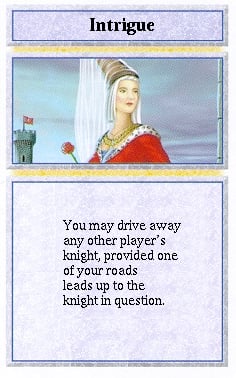 |
2 | You may drive away any other player's knight, provided one of your roads / ships leads up to the knight in question. | This card enables you to move an opposing knight who is blocking a building site or a road extension. You may not automatically place one of your own knights at this location. |
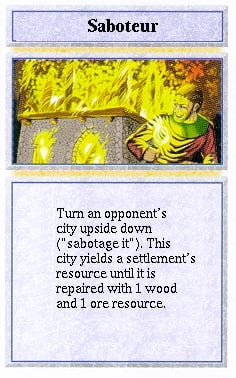 |
2 | Turn an opponent's city upside down ("sabotage it"). This city only yields a settlement's resource until it is repaired with 1 wood and 1 ore resource. | A sabotaged city is still worth 2 victory points. It also counts towards the strength of the Barbarian Army. A city wall stays intact and maintains its effect. |
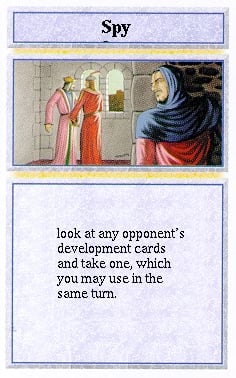 |
3 | Look at any opponent's development cards and take one, which you may use in the same turn | It is allowed to steal a spy from one opponent and use it straight away. |
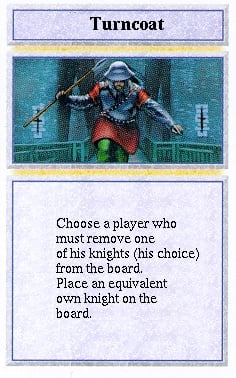 |
2 | Choose a player who must remove one of his knights (his choice) from the board. Place an equivalent own knight one the board | If, on playing this card, your opponent removes a knight which you cannot replace with a knight of your own, you may use a less powerful knight. If you do not have such a knight, you may not place a knight of your own, but your opponent must still remove (one of) his. Should a mighty (most powerful) knight be removed, you may place such a knight on the board even if you have not built a fortress yet. Your knight is in the same state as the one it "replaces". You should only play this card if you space for placing a knight. |
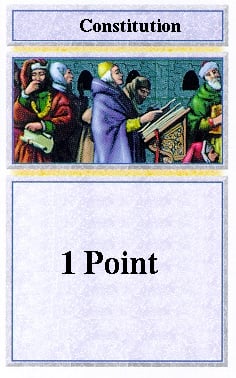 |
1 | 1 victory point | Development cards yielding victory points have to be played immediately and must be visible to all. They cannot be robbed. |
| Name | number in pack | Card Text | Additional remarks |
|
|||
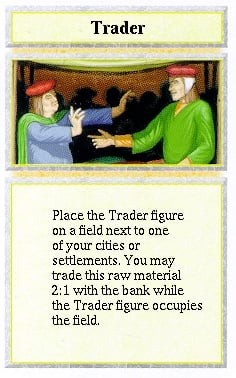 |
6 | Place the trader figure on a field next to one of your cities or settlements. You may trade this raw material 2:1 with the bank while the trader occuoies the field. | As long as the trader stays on the field (in your posession), you may trade this kind of raw material 2:1. The trader is worth 1 victory point. When another player plays a trader card, she gets the trader, the trading advantage as well as the victory point |
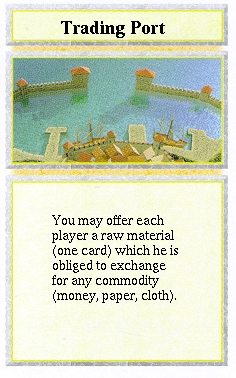 |
2 | You may offer each player a raw material (one card) which he is obliged exchange for any commodity (money, paper, cloth) | You make take advantage of this while it is your turn, but you may only trade once with each player under this condition. If you offer a card to a player who doesn't have any commodities, the exchange is void and you keep your resource card. |
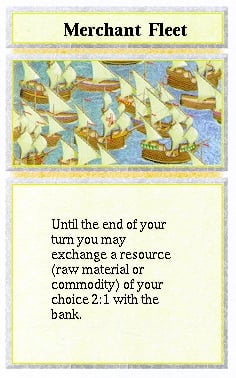 |
2 | Until the end of your turn you may exchange a resource (raw material or commodity)of your choice 2:1. | As always, the 2 cards have to be of the same kind. |
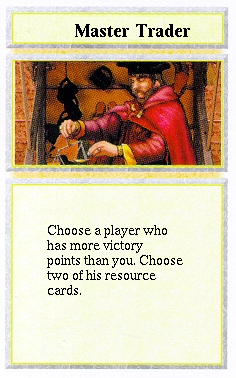 |
2 | Choose a player who has more victory points than you. Choose two of her resource cards. | Yes, you may look at and choose and keep two of the selected player's resource cards |
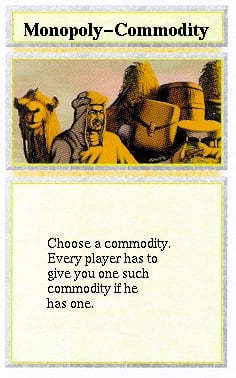 |
2 | Choose a commodity. Every player has to give you one such commodity if he has one. | |
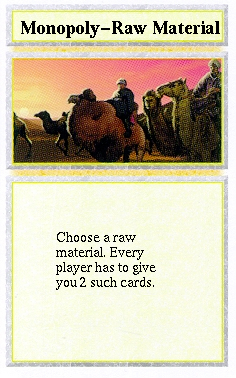 |
4 | Choose a raw material. Every player has to give you 2 such cards. | If a player has only one such resource card, she must give you this one. |
German and English mother-tongue speaker :-).